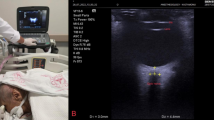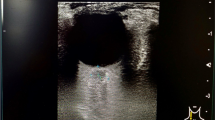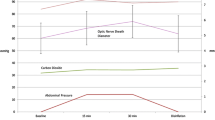Abstract
Purpose
Optic nerve sheath diameter has been used for measure of intracranial pressure. The aim of this study was to evaluate the effect of prone positioning with neck extension on intracranial pressure in infants undergoing craniosynostosis surgery and to determine precautions using optic nerve sheath diameter measurement.
Methods
We enrolled 30 infants who were scheduled for correction of craniosynostosis in which planning included the prone position with neck extension. Optic nerve sheath diameter (anterior/lateral transbulbar approach) was measured 5 times in each eyeball at the following time points: 15 min after intubation in supine position as the baseline value (supine 1); 10 min after final surgical position before skin incision (prone); and 10 min after returning to supine position at the conclusion of surgery (supine 2). Hemodynamic parameters, airway peak pressure, oxygen saturation, and ETCO2 were monitored. Data were analyzed using repeated-measures multivariate analysis of variance to evaluate the effect of different positions under anesthesia on changes in using optic nerve sheath diameter and P < 0.05 was considered to be statistically significant.
Results
There was no difference in optic nerve sheath diameter after prone position with neck extension in all the measure. After surgery, optic nerve sheath diameter was decreased compared with the preoperative baseline values (Rt anterior/lateral 5.6/5.5: 5.4/5.2; Lt anterior/lateral 5.6/5.5: 5.4/5.3, P < 0.05, respectively).
Conclusions
In conclusion, prone positioning with head extension did not further increase intracranial pressure, although the surgical procedure could reduce intracranial pressure in the immediate postoperative period in infants undergoing craniosynostosis surgery.




Similar content being viewed by others
References
Hayward R, Gonsalez S (2005) How low can you go? Intracranial pressure, cerebral perfusion pressure, and respiratory obstruction in children with complex craniosynostosis. J Neurosurg 102(1 Suppl):16–22. https://doi.org/10.3171/ped.2005.102.1.0016
Thomas GP, Johnson D, Byren JC, Judge AD, Jayamohan J, Magdum SA, Richards PG, Wall SA (2015) The incidence of raised intracranial pressure in nonsyndromic sagittal craniosynostosis following primary surgery. J Neurosurg Pediatr 15(4):350–360. https://doi.org/10.3171/2014.11.PEDS1426
Thompson DN, Malcolm GP, Jones BM, Harkness WJ, Hayward RD (1995) Intracranial pressure in single-suture craniosynostosis. Pediatr Neurosurg 22(5):235–240. https://doi.org/10.1159/000120907
Mavrocordatos P, Bissonnette B, Ravussin P (2000) Effects of neck position and head elevation on intracranial pressure in anaesthetized neurosurgical patients: preliminary results. J Neurosurg Anesthesiol 12(1):10–14. https://doi.org/10.1097/00008506-200001000-00003
Roth C, Ferbert A, Deinsberger W, Kleffmann J, Kastner S, Godau J, Schuler M, Tryba M, Gehling M (2014) Does prone positioning increase intracranial pressure? A retrospective analysis of patients with acute brain injury and acute respiratory failure. Neurocrit Care 21(2):186–191. https://doi.org/10.1007/s12028-014-0004-x
Shirodkar CG, Munta K, Rao SM, Mahesh MU (2015) Correlation of measurement of optic nerve sheath diameter using ultrasound with magnetic resonance imaging. Indian J Crit Care Med 19(8):466–470. https://doi.org/10.4103/0972-5229.162465
Haredy M, Zuccoli G, Tamber M, Davis A, Nischal K, Goldstein JA (2018) Use of neuroimaging measurements of optic nerve sheath diameter to assess intracranial pressure in craniosynostosis. Childs Nerv Syst 34(5):939–946. https://doi.org/10.1007/s00381-018-3728-7
Hansen HC, Helmke K (1997) Validation of the optic nerve sheath response to changing cerebrospinal fluid pressure: ultrasound findings during intrathecal infusion tests. J Neurosurg 87(1):34–40. https://doi.org/10.3171/jns.1997.87.1.0034
Helmke K, Hansen HC (1996) Fundamentals of transorbital sonographic evaluation of optic nerve sheath expansion under intracranial hypertension II. Patient study. Pediatr Radiol 26(10):706–710. https://doi.org/10.1007/bf01383384
Girisgin AS, Kalkan E, Kocak S, Cander B, Gul M, Semiz M (2007) The role of optic nerve ultrasonography in the diagnosis of elevated intracranial pressure. Emerg Med J 24(4):251–254. https://doi.org/10.1136/emj.2006.040931
Kimberly HH, Shah S, Marill K, Noble V (2008) Correlation of optic nerve sheath diameter with direct measurement of intracranial pressure. Acad Emerg Med 15(2):201–204. https://doi.org/10.1111/j.1553-2712.2007.00031.x
Lin SD, Kahne KR, El Sherif A, Mennitt K, Kessler D, Ward MJ, Platt SL (2017) The use of ultrasound-measured optic nerve sheath diameter to predict ventriculoperitoneal shunt failure in children. Pediatr Emerg Care. https://doi.org/10.1097/PEC.0000000000001034
Padayachy LC, Padayachy V, Galal U, Gray R, Fieggen AG (2016) The relationship between transorbital ultrasound measurement of the optic nerve sheath diameter (ONSD) and invasively measured ICP in children : Part I: repeatability, observer variability and general analysis. Childs Nerv Syst 32(10):1769–1778. https://doi.org/10.1007/s00381-016-3067-5
Bauerle J, Lochner P, Kaps M, Nedelmann M (2012) Intra- and interobsever reliability of sonographic assessment of the optic nerve sheath diameter in healthy adults. J Neuroimaging 22(1):42–45. https://doi.org/10.1111/j.1552-6569.2010.00546.x
(2017) Practice guidelines for preoperative fasting and the use of pharmacologic agents to reduce the risk of pulmonary aspiration: application to healthy patients undergoing elective procedures: an updated report by the American Society of Anesthesiologists Task Force on Preoperative Fasting and the Use of Pharmacologic Agents to Reduce the Risk of Pulmonary Aspiration. Anesthesiology 126(3):376–393. https://doi.org/10.1097/ALN.0000000000001452
Hall MK, Spiro DM, Sabbaj A, Moore CL, Hopkins KL, Meckler GD (2013) Bedside optic nerve sheath diameter ultrasound for the evaluation of suspected pediatric ventriculoperitoneal shunt failure in the emergency department. Childs Nerv Syst 29(12):2275–2280. https://doi.org/10.1007/s00381-013-2172-y
Ballantyne J, Hollman AS, Hamilton R, Bradnam MS, Carachi R, Young DG, Dutton GN (1999) Transorbital optic nerve sheath ultrasonography in normal children. Clin Radiol 54(11):740–742. https://doi.org/10.1016/s0009-9260(99)91176-5
Chin JH, Seo H, Lee EH, Lee J, Hong JH, Hwang JH, Kim YK (2015) Sonographic optic nerve sheath diameter as a surrogate measure for intracranial pressure in anesthetized patients in the Trendelenburg position. BMC Anesthesiol 15:43. https://doi.org/10.1186/s12871-015-0025-9
Tamburrini G, Caldarelli M, Massimi L, Santini P, Di Rocco C (2005) Intracranial pressure monitoring in children with single suture and complex craniosynostosis: a review. Childs Nerv Syst 21(10):913–921. https://doi.org/10.1007/s00381-004-1117-x
Taylor WJ, Hayward RD, Lasjaunias P, Britto JA, Thompson DN, Jones BM, Evans RD (2001) Enigma of raised intracranial pressure in patients with complex craniosynostosis: the role of abnormal intracranial venous drainage. J Neurosurg 94(3):377–385. https://doi.org/10.3171/jns.2001.94.3.0377
Mundinger GS, Skladman R, Wenger T, Birgfeld CC, Gruss JS, Lee A, Ellenbogen R, Hopper RA (2018) Defining and correcting asymmetry in isolated unilateral frontosphenoidal synostosis: differences in orbital shape, facial scoliosis, and skullbase twist compared to unilateral coronal synostosis. J Craniofac Surg 29(1):29–35. https://doi.org/10.1097/SCS.0000000000004052
Newman WD, Hollman AS, Dutton GN, Carachi R (2002) Measurement of optic nerve sheath diameter by ultrasound: a means of detecting acute raised intracranial pressure in hydrocephalus. Br J Ophthalmol 86(10):1109–1113. https://doi.org/10.1136/bjo.86.10.1109
Thompson DN, Harkness W, Jones B, Gonsalez S, Andar U, Hayward R (1995) Subdural intracranial pressure monitoring in craniosynostosis: its role in surgical management. Childs Nerv Syst 11(5):269–275. https://doi.org/10.1007/bf00301758
Robba C, Bragazzi NL, Bertuccio A, Cardim D, Donnelly J, Sekhon M, Lavinio A, Duane D, Burnstein R, Matta B, Bacigaluppi S, Lattuada M, Czosnyka M (2017) Effects of prone position and positive end-expiratory pressure on noninvasive estimators of ICP: a pilot study. J Neurosurg Anesthesiol 29(3):243–250. https://doi.org/10.1097/ANA.0000000000000295
Petersen LG, Ogoh S (2019) Gravity, intracranial pressure, and cerebral autoregulation. Physiol Rep 7(6):e14039. https://doi.org/10.14814/phy2.14039
Tuite GF, Chong WK, Evanson J, Narita A, Taylor D, Harkness WF, Jones BM, Hayward RD (1996) The effectiveness of papilledema as an indicator of raised intracranial pressure in children with craniosynostosis. Neurosurgery 38(2):272–278
Sujata N, Tobin R, Tamhankar A, Gautam G, Yatoo AH (2019) A randomised trial to compare the increase in intracranial pressure as correlated with the optic nerve sheath diameter during propofol versus sevoflurane-maintained anesthesia in robot-assisted laparoscopic pelvic surgery. J Robot Surg 13(2):267–273. https://doi.org/10.1007/s11701-018-0849-7
Agrawal A, Cheng R, Tang J, Madhok DY (2019) Comparison of two techniques to measure optic nerve sheath diameter in patients at risk for increased intracranial pressure. Crit Care Med. https://doi.org/10.1097/CCM.0000000000003742
Christian EA, Imahiyerobo TA, Nallapa S, Urata M, McComb JG, Krieger MD (2015) Intracranial hypertension after surgical correction for craniosynostosis: a systematic review. Neurosurg Focus 38(5):E6. https://doi.org/10.3171/2015.2.FOCUS14853
Grandhi R, Peitz GW, Foley LM, Bonfield CM, Fellows-Mayle W, Hitchens TK, Mooney MP (2018) The influence of suturectomy on age-related changes in cerebral blood flow in rabbits with familial bicoronal suture craniosynostosis: a quantitative analysis. PLoS One 13(6):e0197296. https://doi.org/10.1371/journal.pone.0197296
Author information
Authors and Affiliations
Contributions
Soobin Yoon, MD, helped write and edit the manuscript. Sang-Hwan Ji, MD, helped in the ONSD measurement and in editing the manuscript. Young-Eun Jang Yoon, MD, helped in the ONSD measurement and in editing the manuscript. Eun-Hee Kim, MD, helped in the ONSD measurement and statistics results. Ji-Hyun Lee, MD, PhD, helped in the study design and in editing the manuscript. Jin-Tae Kim, MD, PhD, helped in writing the study and in editing the manuscript. Hee-Soo Kim, MD, PhD, designed the study and edited the manuscript.
Corresponding author
Ethics declarations
The study protocol was approved by the Institutional Review Board at Seoul National University Hospital (SNUH IRB 1703-147-840, April 2017).
Conflict of interest
None declared.
Additional information
Publisher’s note
Springer Nature remains neutral with regard to jurisdictional claims in published maps and institutional affiliations.
Rights and permissions
About this article
Cite this article
Yoon, SB., Ji, SH., Jang, YE. et al. Effects of prone positioning with neck extension on intracranial pressure according to optic nerve sheath diameter measured using ultrasound in children. Childs Nerv Syst 36, 1001–1007 (2020). https://doi.org/10.1007/s00381-019-04442-3
Received:
Accepted:
Published:
Issue Date:
DOI: https://doi.org/10.1007/s00381-019-04442-3




